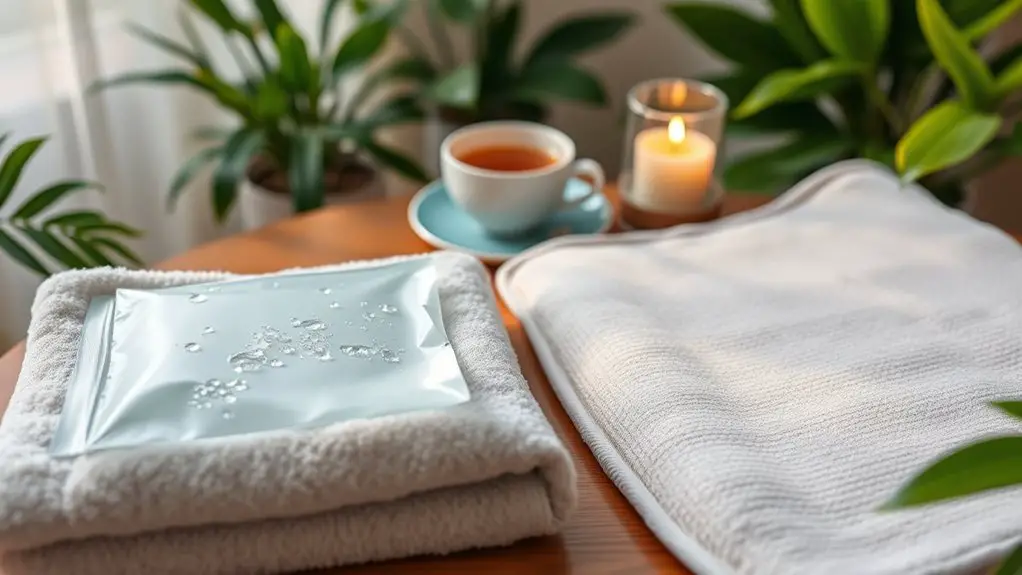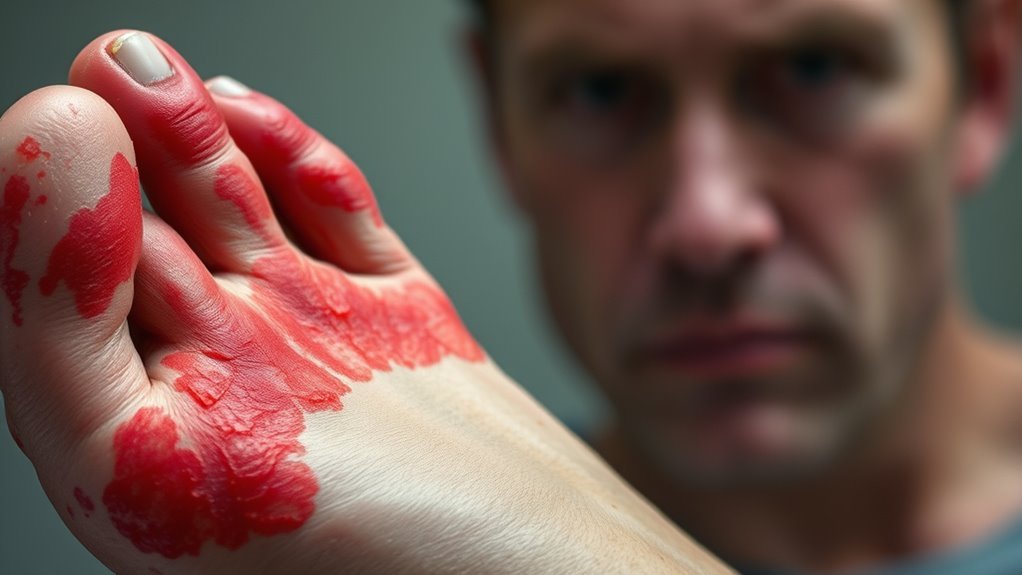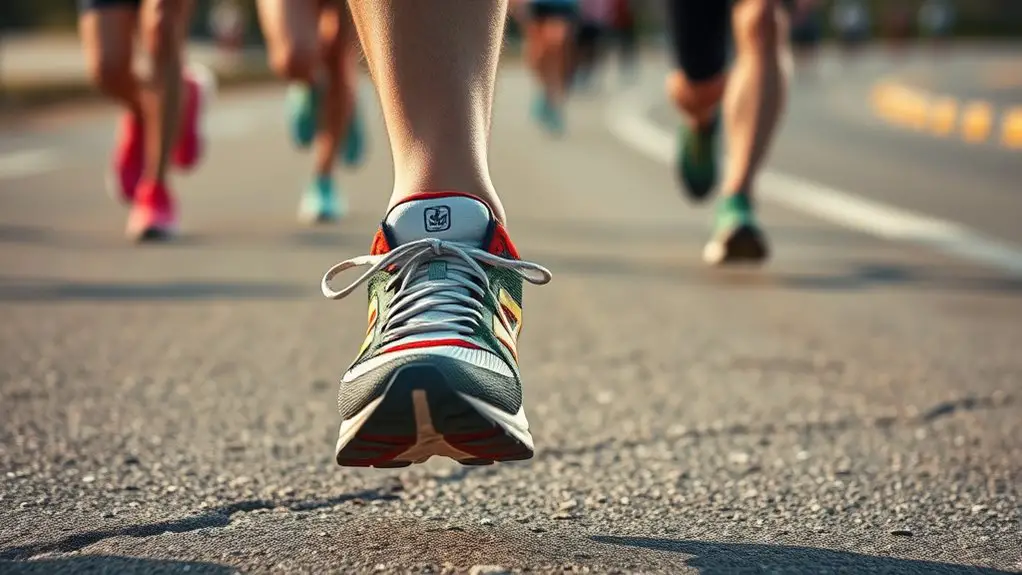For effective recovery, you should consider both cold and heat therapy. Cold therapy, like ice packs and cryotherapy, reduces swelling and numbs pain right after an injury. Heat therapy, using heating pads or warm baths, promotes blood flow and relaxes tense muscles. For best results, apply cold immediately after injury, then switch to heat after a day or two. Explore how to combine these methods for ideal recovery and discover more tips on enhancing your healing process.
Understanding Cold Therapy: How It Works
When you're dealing with soreness or inflammation, understanding how cold therapy works can be a game changer. Cold therapy primarily involves applying ice or cold packs to the affected area, which constricts blood vessels and reduces blood flow. This process helps numb the pain and minimizes swelling, giving you a break from discomfort.
The key is timing—applying cold therapy soon after an injury can be most effective. It's not just for athletes; anyone can benefit from this method. You'll find that the relief it provides can empower you to regain control over your body and activities. Just remember to use a barrier, like a cloth, to protect your skin from frostbite.
Benefits of Cold Therapy for Recovery
Cold therapy offers several benefits for recovery that can greatly enhance your healing process. First, it effectively reduces inflammation and swelling, which helps to alleviate pain and discomfort. You'll find that icing an injury right after it occurs can limit tissue damage and promote quicker healing.
Additionally, cold therapy can numb the affected area, providing immediate relief from sharp or intense pain, allowing you to move freely without as much discomfort. It also helps to enhance circulation once the cold is removed, promoting recovery by delivering oxygen and nutrients to the area.
This method can be easily integrated into your routine, whether you're an athlete or just someone looking to recover from daily strains. Overall, cold therapy is a powerful tool that can empower your body to heal more efficiently, giving you the freedom to return to your activities sooner and with less pain.
Best Cold Therapy Methods to Try
There are several effective cold therapy methods you can try to enhance your recovery process. Each method has its benefits, so you can choose what suits you best. Here's a quick overview of some popular options:
| Method | Benefits |
|---|---|
| Ice Packs | Reduces swelling and inflammation |
| Cold Water Immersion | Eases muscle soreness and fatigue |
| Cryotherapy | Speeds up recovery time |
| Frozen Peas | Molds easily to body contours |
Understanding Heat Therapy: How It Works
Heat therapy works by increasing blood flow to the affected area, which helps to relax muscles and alleviate tension. When you apply heat, it can reduce pain and stiffness, making it a great option for recovery. Understanding these mechanisms can help you make the most of your heat therapy treatments.
Mechanism of Heat Therapy
Understanding how heat therapy works involves recognizing its effects on the body. When you apply heat, it increases blood flow and relaxes muscles, helping to alleviate tension. Here's what happens:
- Enhances circulation: More blood means more oxygen and nutrients for your muscles, paving the way for recovery.
- Reduces stiffness: Heat loosens tight muscles and joints, giving you the freedom to move more freely.
- Eases pain: The warmth soothes nerve endings, helping to diminish discomfort and bring relief.
- Promotes relaxation: Heat therapy creates a sense of calm, allowing you to unwind and escape daily stress.
Benefits of Heat Application
Utilizing heat therapy can offer numerous benefits that enhance your recovery process. It increases blood flow, delivering more oxygen and nutrients to your muscles, which helps with healing. Heat can also soothe stiffness and relax tight muscles, making movements easier and more comfortable. If you're dealing with chronic pain or tension, applying heat can provide immediate relief and a sense of comfort. Plus, it can be a great way to unwind and de-stress after a long day, allowing you the freedom to feel more at ease in your body. Whether it's a warm towel, heating pad, or hot bath, heat therapy can be a simple yet powerful tool in your recovery toolkit. Embrace the warmth and enjoy the benefits!
Benefits of Heat Therapy for Recovery
When you're looking to enhance recovery, heat therapy often stands out for its numerous benefits. This method can be a game-changer, helping you regain your freedom and feel your best. Here are some key advantages:
- Increased Blood Flow: Heat opens up blood vessels, boosting circulation and delivering more oxygen and nutrients to your muscles.
- Reduced Muscle Tension: A warm sensation can relax tight muscles, easing discomfort and allowing for smoother movement.
- Enhanced Flexibility: Applying heat can improve your range of motion, which helps you stay active and agile in your daily life.
- Pain Relief: Heat therapy can alleviate chronic pain, giving you the freedom to engage in activities you love without discomfort.
Embracing heat therapy can empower you to recover faster and reclaim your energy, so you can enjoy life to the fullest.
Best Heat Therapy Methods to Try
Whether you're dealing with muscle soreness or just looking to relax, exploring various heat therapy methods can make a significant difference in your recovery. One popular option is a heating pad, perfect for targeting specific areas like your back or neck. If you prefer a more immersive experience, try a warm bath or shower; the steam can work wonders for your muscles.
For a portable option, consider heat wraps. They conform to your body and provide consistent warmth while you're on the go. Another great choice is a hot water bottle, which you can easily fill and position wherever you need relief.
Don't forget about infrared saunas! They promote relaxation and help with muscle recovery by penetrating deeper into your tissues. With all these options, you can find the ideal heat therapy method that fits your lifestyle and needs, giving you the freedom to recover effectively.
When to Use Cold vs. Heat Therapy
Knowing when to use cold or heat therapy can make a big difference in your recovery process. For acute injuries, like sprains or strains, cold therapy helps reduce swelling and numb the pain. On the other hand, if you're dealing with chronic pain, heat therapy can soothe tight muscles and improve blood flow.
Acute Injuries Treatment
In the aftermath of an acute injury, choosing between cold and heat therapy can greatly impact your recovery. Understanding when to use each method empowers you to take charge of your healing journey.
- Cold therapy reduces swelling and numbs pain, giving you immediate relief.
- Heat therapy increases blood flow, promoting relaxation and healing in the muscles.
- Timing is essential: use cold within the first 48 hours post-injury.
- Listening to your body is key—if something feels off, adjust your approach.
Chronic Pain Relief
Chronic pain can be a lingering issue that requires different strategies compared to acute injuries. When you're dealing with ongoing discomfort, heat therapy can often work wonders. Applying a warm compress or heating pad can help relax tense muscles and improve blood flow, offering you some much-needed relief.
On the other hand, cold therapy can be beneficial if inflammation is part of your chronic pain. Ice packs can numb the area and reduce swelling, giving you a break from persistent discomfort.
Ultimately, it's about listening to your body. You might find that alternating between heat and cold provides the best results, allowing you to reclaim your freedom and enjoy life with less pain.
Tips for Effective Cold and Heat Therapy
While both cold and heat therapy can be effective for recovery, using them correctly is key to maximizing their benefits. You deserve the freedom to heal efficiently and feel your best. Here are some tips to help you get the most out of your therapy sessions:
Using cold and heat therapy correctly is essential for effective recovery and overall well-being.
- Know When to Use Each: Cold is great for reducing swelling post-injury, while heat helps soothe tense muscles and improve circulation.
- Time It Right: Stick to 15-20 minutes for each session to avoid skin damage or discomfort.
- Create a Comfortable Environment: Use your favorite blanket or pillow to make your therapy sessions more enjoyable and relaxing.
- Listen to Your Body: If something doesn't feel right, don't hesitate to adjust your method or consult a professional.
Embrace these tips, and you'll be on your way to a quicker, more fulfilling recovery!
Combining Cold and Heat Therapy for Optimal Recovery
Combining cold and heat therapy can greatly enhance your recovery process, especially when used strategically. Start with cold therapy to reduce inflammation and numb pain. This is especially effective right after an injury or a strenuous workout. You'll feel immediate relief, allowing your body to begin healing.
After a day or two, switch to heat therapy. Applying warmth increases blood flow, helping to relax tight muscles and promote healing. This cycle of cold and heat can improve flexibility and ease discomfort, letting you feel more like yourself again. Additionally, listening to your body during this process is crucial to ensure you are not overdoing it and are allowing adequate recovery time.
You can even alternate between the two methods. Just make sure to listen to your body; if something doesn't feel right, adjust accordingly. Embracing this combination can empower you on your recovery journey, giving you the freedom to move without pain and get back to doing what you love. Enjoy the journey to ideal recovery!
Frequently Asked Questions
Can I Use Cold and Heat Therapy Together?
Yes, you can use cold and heat therapy together! Just alternate between them carefully. Cold reduces inflammation, while heat promotes circulation. Listen to your body, and adjust based on how you feel for best relief.
How Long Should I Apply Cold or Heat Therapy?
Imagine a soothing embrace, a gentle warmth or invigorating chill. You should apply cold therapy for 15-20 minutes and heat therapy for 20-30 minutes, allowing your body the freedom to relax and recover.
Are There Any Risks With Cold or Heat Therapy?
Yes, there can be risks with cold or heat therapy. Overusing either method might cause skin damage or worsen inflammation. Always monitor your body's response, and don't hesitate to consult a healthcare professional if unsure.
Can Cold or Heat Therapy Be Used During Workouts?
Imagine your body as a fine-tuned engine. You can use cold or heat therapy during workouts, but be cautious; it's like choosing the right fuel. Balance is key to maintaining freedom in your movements.
What Conditions Should Avoid Cold or Heat Therapy?
You should avoid cold therapy if you have poor circulation, nerve damage, or are sensitive to cold. Heat therapy isn't ideal for inflammation, open wounds, or certain skin conditions. Always consult a professional if unsure.




